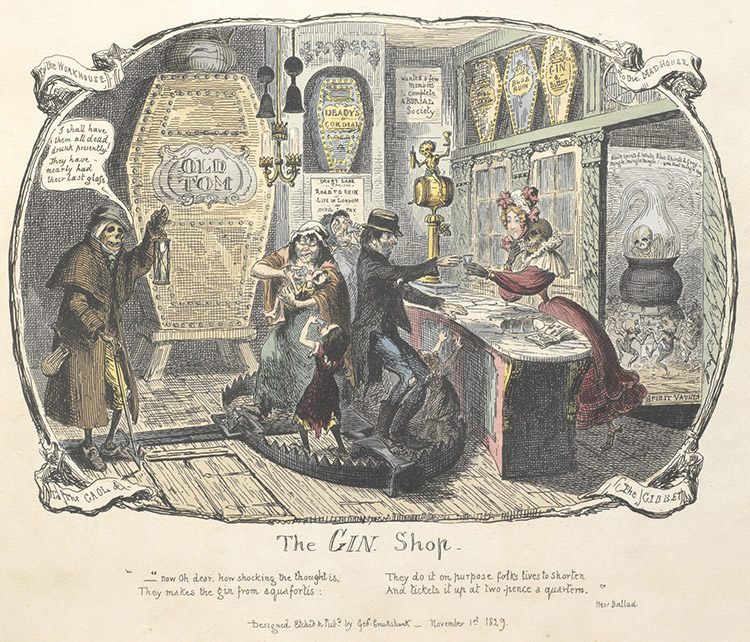
The Gin. Since the big success and the large consumption of Gin at the moment, it is good to clear things up by retracing the story, sometimes fascinating and sometimes dramatic, of this antique spirit.

During the 600, the juniper berry was considered for curing stomach illnesses; furthermore, it was also considered an effective remedy against the pest. Bandages soaked with essential oils and juniper berries with rosemary and garlic were put inside a mask, equipped with filters, and used by the “pest-doctors“ to chase away the disease and the stench that reigned in these houses of the ill.
In the XVII century, in Flanders, the first distillery was opened by Franciscus De La Boe Sylvius, a Dutch naturalist, and doctor from Leiden. It seems that Doctor Salyius himself, connoisseur of the beneficial properties enclosed in the essential oil of the juniper, obtained a therapeutic oil at low cost: the Genever, thanks to an ulterior distillation of an infusion of berries macerated in pure alcohol. The efficiency of this “medicine“ quickly spread throughout Holland, appreciated by many dutch travelers and sailors for its characteristics.
Imported for the history of this product was the discovery by the English soldiers on their return from the Netherlands. By the end of the XVI century, the Dutch sold the Genever in England, where a royal approval for the distillation occurred. Many distilleries surfaced that started to produce aquavit similar to the
Genever, which soon enough was called Gin. They also adopted a strategy to increase the production of cereals and raise the consumption of Gin, since the distilleries were liberalized and the taxes on alcohol were considerably reduced. That is how the era of the Gin began.

Between 1690 and 1751, the consumption of Gin in Grand Britain grew in an exponential manner, especially in London. This period is historically remembered as “The Gin Craze. “ The Gin was cheap, inebriated quickly and helped the poor to forget their misery, it became the source of social disorder, and in the poor neighborhoods, the people lived in a continuous state of drunkenness. To retain the phenomenon, the Parliament adopted the first “Gin Act,” a law to regulate the matter.
The direct consequence was a proliferation of clandestine distilleries responsible for the production of alcohol toxic to the consumer’s health.
In 1751 a new law from the Parliament put forward necessary measures to levee the problem and tried to straighten the producers towards a more attentive and qualitative distillation of the final product. Other than imposing new taxes on Gin, this new law created awareness of the consumption and made it so that the production of quality Gin increased significantly.
THE SPIRIT
The definition of Gin is cereal distillation, primarily obtained by wheat and rye, white and colorless, flavored with herbs, spices, roots, and juniper berries.
Each producer is free to choose the typology and the quantity of the botanicals used and personalizing their own Gin by enhancing it with flowers, plants, fruits, and vegetables (for example, coriander seeds, angelica roots, gorse, cardamom, dried citrus peels, cassis, licorice, wild plums, cinnamon, and other aromatic herbs) rendering his recipe unique and one of inimitable.
In a not-so-distant past, due to the trend of the Vodkas obtained with different raw materials than cereals and the lack of precise regulations, also the Gin began to be produced with different raw materials than cereals such as apples, grapes, and potatoes.
Currently, we can distinguish between two spirits where the juniper is the characteristic element: the dutch Genever, which includes the fermentation of cereals and is the distillation before the adding for aromas (botanic) and juniper; the English Gin, redistills of cereal in which its vapor is being circulated through the aromatic ingredients (botanic) that transmit their aroma. This production style goes by the name of London Dry Gin.

Another system consists of macerating berries and botanicals into the alcohol before a final distillation. The alcohol with the macerated Botanics, during its evaporation, carries the aromatic components along with it. The introduction of “Coffey“ stills to the running distillation was the technical innovation that produced a more neutral spirit.
The Broker’s and the Tanqueray are examples of London Dry Gin on the market. Colorless, dry, perfumed, and particularly suited for mixing.

It is important to consider a Gin that tells a story of travels, the ocean, the exotic spices, the tradition, symbol of the United Kingdom, in particular the Plymouth Gin. The Plymouth Gin was born in 1793, for medical purposes, in a distillery situated in the building that, in 1620, took the fathers Pellegrini in on the night before they set sail for America. It has an intense perfume, perfectly balanced between its 7 botanicals. The Plymouth appellation is only given to the Gin produced in the homonymous locality of the Black Friars distillation.
Nowadays, the Gin finds ample use in both the preparations of cocktails and straight consumption. The selection of the typologies present from around the world on the market is wide-ranging.
Do not miss any news and the highest rated spirits!